
Squatting is the action of occupying an abandoned or unoccupied area of land or a building, usually residential that the squatter does not own, rent or otherwise have lawful permission to use. The United Nations estimated in 2003 that there were one billion slum residents and squatters globally. Squatting occurs worldwide and tends to occur when people find empty buildings or land to occupy for housing. It has a long history, broken down by country below.
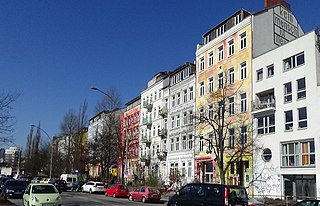
Hafenstraße is a street in St. Pauli, a quarter of Hamburg, Germany, known for its legalized squats. The squats were occupied in 1981 and became a figurehead for autonomist and anti-imperialist politics. After a prolonged battle with the city council which involved demonstrations of over 10,000 people, the buildings were legalized in the 1990s. Today they are owned by a self-organised cooperative.
Thomas Weissbecker, known as Tommy (1949–1972), was a German leftwing militant shot dead by police at the age of 23. He was involved with the Haschrebellen, the Tupamaros West-Berlin, the 2 June Movement and the Red Army Faction. After his death, the Tommy Weisbecker Haus was squatted in Berlin.

The "Rauch-Haus-Song" is a track performed by West Berlin band Ton Steine Scherben on their second studio album Keine Macht für Niemand. It has become famous in leftwing circles in Germany.
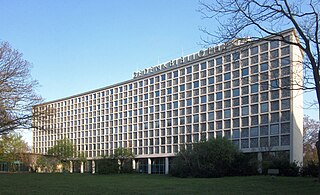
The Amerika-Gedenkbibliothek is one of the largest public libraries in Berlin, Germany. It was co-financed by a donation from the United States. The building was designed by American and German architects, including Fritz Bornemann and Willy Kreuer. It was opened on September 17, 1954, and was originally planned to become the Central Library of Berlin.

The Fichte-Bunker is a nineteenth-century gasometer in the Kreuzberg district of Berlin, Germany that was made into an air-raid shelter in World War II and subsequently was used as a shelter for the homeless and for refugees, in particular for those fleeing East Berlin for the West. It is the last remaining brick gasometer in Berlin.

In England and Wales, squatting – taking possession of land or an empty house the squatter does not own – is a criminal or civil offence, depending on circumstances. People squat for a variety of reasons which include needing a home, protest, poverty, and recreation. Many squats are residential; some are also opened as social centres. Land may be occupied by New Age travellers or treesitters.
In the United States, squatting occurs when a person enters land that does not belong to them without lawful permission and proceeds to act in the manner of an owner. Historically, squatting occurred during the settlement of the Midwest when colonial European settlers established land rights and during the California Gold Rush. There was squatting during the Great Depression in Hoovervilles and also during World War II. Shanty towns returned to the US after the Great Recession (2007–2009) and in the 2010s, there were increasing numbers of people occupying foreclosed homes using fraudulent documents. In some cases, a squatter may be able to obtain ownership of property through adverse possession.
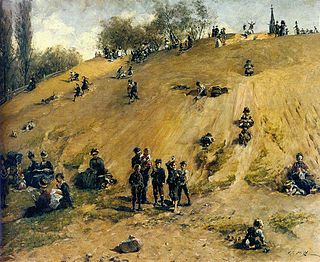
The Kreuzberg is a hill in the Kreuzberg locality of Berlin, Germany, in former West Berlin. It rises about 66 m (217 ft) above the sea level. It was named by King Frederick William III of Prussia after the Iron Cross which crowns the top of the Prussian National Monument for the Liberation Wars, designed by Karl Friedrich Schinkel, on its inauguration on 30 March 1821. On 27 September 1921 the borough assembly of the VIth borough of Berlin decided to name the borough after the hill. The borough was subsequently downgraded to a locality in 2001.

The Friedrich-von-Raumer-Bibliothek is a public library in Berlin. It was founded in 1850 and is located in Berlin's Kreuzberg locality on Dudenstraße. After several moves the library found its current location in 1955 in a block of flats of the services trade union Ver.Di by Franz Hoffmann and Max Taut. The library is located in the rotunda, westerly protruding from the block of flats, and in the ground floor of that block. The Raumer Library is a so-called neighbourhood library (Stadtteilbibliothek) within the Stadtbibliothek Friedrichshain-Kreuzberg, and as such part of the Verbund der Öffentlichen Bibliotheken Berlins (VÖBB), the network of public libraries owned by the city-state.

Muratti is a brand of cigarettes, currently owned and manufactured by Philip Morris International. Several Muratti variants have been introduced over the years and were also sold as Ambassador, Ariston, Cabinet, Gentry, Iplic, Peer and Regent.

Squatting in the Republic of Ireland is the occupation of unused land or derelict buildings without the permission of the owner. In the 1960s, the Dublin Housing Action Committee highlighted the housing crisis by squatting buildings. From the 1990s onwards there have been occasional political squats in Cork and Dublin such as Grangegorman, the Barricade Inn, the Bolt Hostel, Connolly Barracks, That Social Centre and James Connolly House.

Silvio Meier (1965–1992) was an East German activist and squatter who was killed by neo-Nazis in Berlin on 21 November 1992. After moving to East Berlin in 1986, Meier became involved in oppositional politics with the Church from Below. His death has been commemorated with an annual memorial march and the renaming of a street in the Berlin district of Friedrichshain.
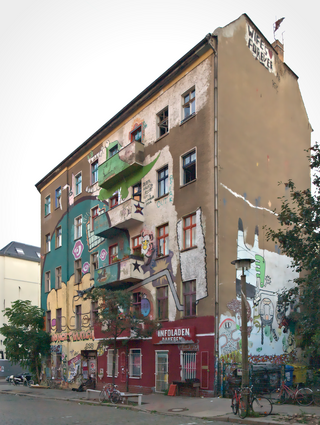
Liebig 34 was an anarchist squat at Liebigstraße 34 in the Friedrichshain-Kreuzberg district of Berlin. It was occupied in 1990 and cleared by eviction in 2020. The squat hosted an anarcha-feminist housing co-operative, the L34-Bar and an infoshop called Daneben on the ground floor.

Squatting in Norway is taking possession of land or an empty house without the permission of the owner. The first public occupation was Hjelmsgate 3 in 1969 and self-managed social centres which were first squatted and then legalized include the Blitz House, Hausmania and UFFA. Brakkebygrenda was a land squat which has twice been evicted.

Urban areas in the Philippines such as Metro Manila, Metro Cebu, and Metro Davao have large informal settlements. The Philippine Statistics Authority defines a squatter, or alternatively "informal dwellers", as "One who settles on the land of another without title or right or without the owner's consent whether in urban or rural areas". Squatting is criminalized by the Urban Development and Housing Act of 1992, also known as the Lina Law. There have been various attempts to regularize squatter settlements, such as the Zonal Improvement Program and the Community Mortgage Program. In 2018, the Philippine Statistics Authority estimated that out of the country's population of about 106 million, 4.5 million were homeless.
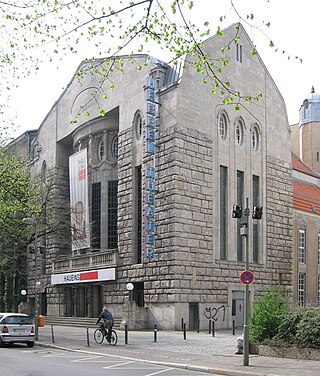
The Hebbel-Theater is a historic theatre building for plays in Berlin-Kreuzberg, Germany. It has been a venue of the company Hebbel am Ufer (HAU) from 2003.

Squatting in Croatia has existed as a phenomenon since the decline of the Roman Empire. In the 1960s much private housing in major cities was illegally constructed or expanded and since the 1990s squatting is used as a tactic by feminists, punks and anarchists. Well-known self-managed social centres such as the cultural centre Karlo Rojc in Pula, Nigdjezemska in Zadar and (AKC) Medika in Zagreb.
The modern political squatting movement began in Hamburg, Germany, when Neue Große Bergstraße 226 was occupied in 1970. Squatters wanted to provide housing for themselves amongst other demands such as preventing buildings from being demolished and finding space for cultural activities. The Hafenstraße buildings were first occupied in 1981 and were finally legalized after a long political struggle in 1995. The still extant Rote Flora self-managed social centre was occupied in 1989. Squatting actions continue into the present; more recent attempts are quickly evicted, although the Gängeviertel buildings were squatted and legalized in the 2010s.

Georg von Rauch Haus is a squat in Kreuzberg, Berlin, established in 1971. It became an important center for the city's left-wing/countercultural milieu in the early 1970s.

















